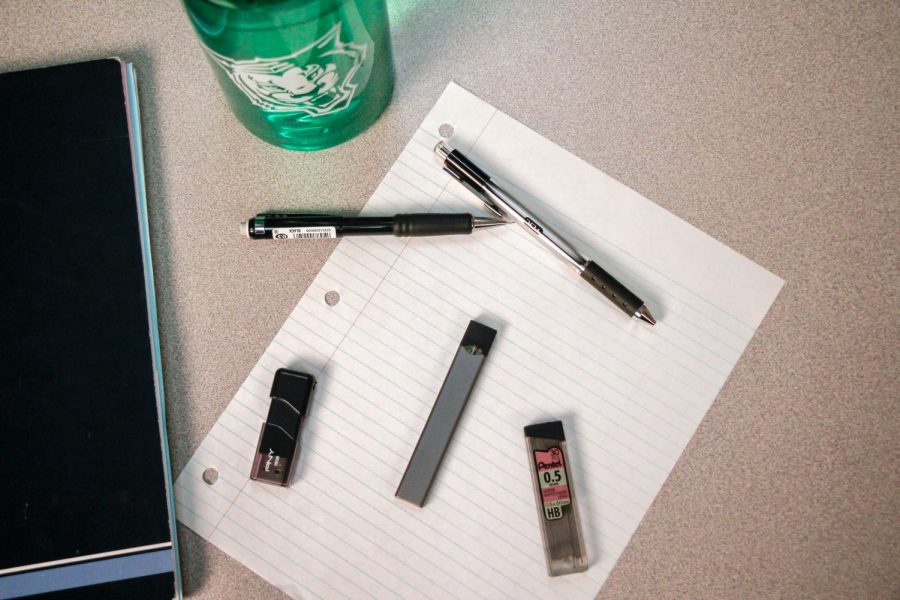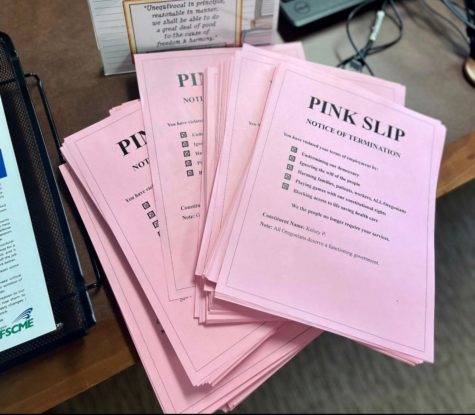Clearing the air
Part of the appeal with Juuls is that they are discreet. Can you spot the Juul in this photo?
February 12, 2018
Adults mistaking Juuls for flash drives? A graveyard of Juul pods growing in the parking lot? True or false, the rumors highlight a growing trend that can’t be ignored. In the 2016 National Youth Tobacco Survey, 20.2 percent of surveyed high school students reported they were currently using tobacco products, with 11.3 percent of them reporting they used e-cigarettes. While smoking cigarettes is declining, e-cigarette use is on the rise. According to an anonymous survey of 111 students at Tigard High, 25.2 percent of the surveyed students reported using a vape device within the past 30 days, and 34.5 percent of users reported that they used one daily. 33.3 percent of the seniors who were surveyed reported using one in the past 30 days. 64.9 percent of students reported seeing a device on campus within the last 30 days.
What are e-cigarettes?
When the user inhales the contents of the device, a battery heats the liquid of the user’s choice, which then turns into an inhalable vapor. Some companies offer nicotine-free liquids, but many still contain nicotine, the addictive chemical in cigarettes. Additionally, vape pens can be filled with THC as well. Juul is a brand name for a particular type of vape pen. Juuls are sleek, thin, and look very similar to a USB, making it easy for students to conceal and use them at school. E-cigarettes offer multiple fruit flavors such as mango or a variety of fruit medleys. According to the CDC these flavors appeal more to the younger crowd and have been used to draw teens into using nicotine. Part of the appeal of vaping is that the secondhand smoke that comes from vaping and e-cigs is simply water vapor and, in theory, isn’t harmful at all. Vape devices are more discreet and seem to be healthier than regular smoking. Former school board member Dr. Barry Albertson expressed concern that students may be led to believe that there’s a greatly reduced risk when using vape pens compared to traditional forms of smoking. “These people [who market the vape pens] may even tell you that the risk is zero and what you are getting into your mouth, throat and lungs is ‘only’ the nicotine and THC from the marijuana,” Albertson said. “But remember, both these compounds are in and of themselves very habit- forming and addictive.” Health teacher Mindy Yarnell shared her concern with the consequences that young smokers will have to go through. “Talk to any smoker years into smoking, and they tell you they wish they had never started because it’s so hard to stop,” Yarnell said.
Laws Surrounding Vaping
As of Jan. 1, a law took effect in Oregon that outlawed the sale of any tobacco and vape products to people under the age of 21. Oregon is the fifth state to raise the legal age from 18 to 21. A 2015 report from the Institute of Medicine showed that raising the smoking age to 21 could prevent around 223,000 premature deaths among Americans born between 2000 and 2019. Additionally, a law that took effect on Jan. 1, 2016, expanded the Oregon Indoor Clean Air Act to include e-cigarettes, vape pens, and other devices. The OICAA now bans the use of e-cigarettes and other inhalant delivery systems in workplaces, restaurants, bars and other indoor public places in Oregon. These laws may help to curb the growing uptick in student use.
Rules for School
High School Security Lead Stace Shillitto explained that security deals with students in possession of vape pens or other vaping devices on a nearly biweekly basis. “It’ll go in waves,” Shillitto said. “Sometimes we’ll grab two or three kids that come into from the neighborhood that we’ve gotten a report on.” Campus security policy on vape pens and related devices is the same as their policy on cigarettes, chew, and other tobacco products—getting caught with one will typically land you a one to three day in school suspension, and the device is confiscated. According to Shillitto, many instances of students in possession of vape devices are reported by other students. “I’ve worked here 26 years, I’ve built great relationships with kids, and I get information from students a lot of the times that say, ‘Hey, so- and-so is in the bathroom vaping’… nine out of ten times it’s very good information and we’re able to deal with it.” Shillitto mentioned that one of the main issues they face when confiscating these devices is having to get the police involved to test if the “vape juice” contains nicotine, the highly addictive stimulant found in tobacco, or THC oil, the main compound in marijuana that causes a high sensation. While a strictly flavored vapor oil will likely just result in an in-school suspension, a nicotine or THC-infused oil can land a student in legal trouble: “For [nicotine], they could be getting an MIP [Minor In Possession] for that, and marijuana is usually a one hundred percent yes,” Shillitto said. “If it’s just [nicotine], a lot of it will be up to the discretion of the police officer.” One of Shillitto’s jobs in the district is “to get this information to our schools, let them know what we’re seeing, let them know what’s out there, and just kind of try to stay ahead of the game.” He also said that because of the more inconspicuous design of Juuls, they are a little harder to regulate than a ‘traditional’ vape pen.
Health Effects
Juuls are being called “cigarettes for the next generation.” A close look at the ingredients of these pods reveal that many of the ingredients are also used in food that is consumed every day. Although the FDA hasn’t labeled these substances as officially unsafe, it hasn’t deemed them safe to use either. Research is still underway to discover the effects of these ingredients. Dr. Albertson believes that smoking any substances, food-grade or not, has the potential to damage your lungs. “I can tell you from my perspective that the single worst thing young people can do to jeopardize their health is to smoke, smoke anything, breathe [or] inhale anything into your mouth, oropharynx, trachea and lungs that’s not ‘plain old air’,” Albertson said. The most shocking health effect of these next-gen cigarettes is the fact that each Juul pod contains 59 mg/ mL of nicotine, the same amount found in one pack of cigarettes. Nicotine has side effects including nausea, vomiting, and heartburn. More long-term effects include an increased risk of stroke, constrictions, and diseases of the coronary artery. Nicotine is also highly addictive. The Juul pod has become popular with teens and high schoolers due to its discreet container and small size. Juul seems to be aware of its underage user base as well, with the website stating that the company uses “industry-leading” ID-Match to verify that online purchasers are over 21. A search on YouTube for “juuls” produces hundreds of videos with titles like “Sneaking juul into school” and “Juuling at School Challenge.” Much like other drugs, Juul usage has increased due to popularization on social media. Yarnell teaches her freshmen about the risks associated with vaping and juuling. “I wish teens would realize it’s as bad as smoking. It’s an addiction. It lasts forever,” Yarnell said.
Is it prevalent at THS?
With almost 65 percent of surveyed students having seen an e-cigarette or similar device on campus in the past month, it is clear that more action needs to be taken. Yarnell recognizes that some students are vaping in the bathrooms and knows that the lack of a smoky smell can make it easier to hide than smoking cigarettes. “People can’t really go by and say you’ve been smoking because there’s no smell,” Yarnell said. Spanish teacher Alexis Buschert has heard about the problem. “I have never personally seen someone vape in my class, but I try to keep a close eye on my students at all times,” Buschert said. Even teachers with keen eyes need to be vigilant, however. At least one student who was interviewed in the process of writing this article admitted to having vaped in class.
What is the takeaway?
In the 1950’s, before people understood the health consequences, smoking cigarettes was culturally accepted, with students and faculty even having a designated area at schools where you could go to light one up. Custodians recently unearthed an old sign in the storage area. It said, “Smoking permitted [sic] only before school – during first period release – lunch period. Violators will be subject to suspension.” The sign used to hang in the pit, which was where the courtyard is located now, so students would know when they were allowed to smoke. Clearly the standards continue to shift as we learn more about the harmful effects of all forms of cigarettes and smoking. “People don’t realize the similar risks it has to smoking cigarettes,” sophomore Ethan McClelland said. “It still has the same effects to your body….Students have been taught the damaging risks of cigarettes and that’s why it’s not as cool anymore, even though juuling and vaping have the same outcome in the end.” Because the potential long-term risks haven’t been studied enough yet, some people think it seems like a healthier option. “I think it’s socially accepted in our age group because they think it is not as gross as cigarettes,” junior Olivia MacFarlane said. “This is the cigarette of our generation.” Perhaps as scientists study the risks and the public becomes more aware, e-cigarettes will fall out of favor, but if history is any indicator, it is likely a new unhealthy trend will emerge from the water-vapor haze.

Part of the appeal with Juuls is that they are discreet. Can you spot the Juul in this photo?

















